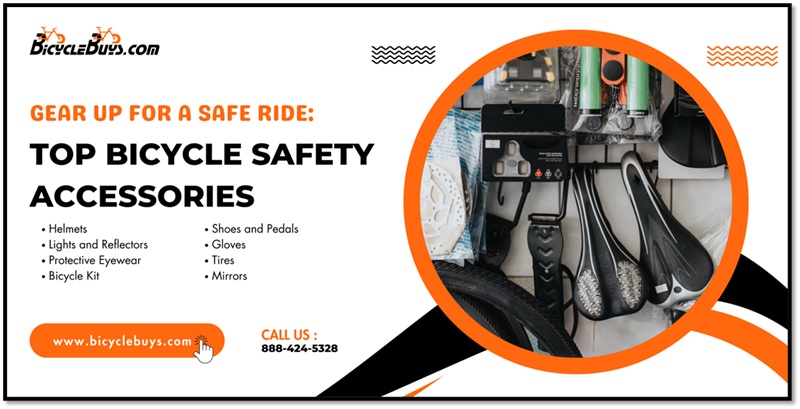Gear Up for a Safe Ride: Top Bicycle Safety Accessories
One of the best physical activities you can engage in is biking. Along with being an excellent cardio workout, it also lowers tension and anxiety. These advantages are enough reasons to cycle on occasion. Remember to pack bike safety gear if you plan to buy a bicycle for your upcoming holiday; these items can be vital in unfortunate circumstances. It is best to be prepared because it might be challenging to predict what will happen, especially when driving.
This post compiles a list of bike safety equipment to help you prepare for your upcoming ride.
Some Safety Gear for Riding a Bicycle
This is the gear list you should have before starting your next bike excursion.
Helmets
Bicycle helmets are made to protect against impacts from realistic falls to the ground that are reproduced in a lab setting. According to certain studies, helmets can effectively reduce the severity of injuries even in high-speed collisions with moving cars. Despite minor regional variations in helmet requirements, most helmets provide a comparable level of safety, independent of cost or additional features. Therefore, the main variations across models are fit, level of ventilation, weight, and styling. Many companies have recently introduced road helmets that are marginally more aerodynamic, some of which do make a difference even when pedaling at slower, ultra-distance cycling rates.
Gloves
The glove is likely the most commonly used bicycle safety gear, except helmets. When you fall on concrete or other hard surfaces, gloves will shield your hands’ palm skin. On extended rides, some are padded to protect the hands from compressive stress from the handlebars. They allow you to stop when you ride through a patch of glass so you can remove the glass fragments from your tires before the glass completely pierces the tread. Gloves are strongly advised. For summertime use, we prefer the washable ones. The non-breathable ones get wet on every ride in the winter, and they must be thoroughly dried before being used again to prevent turning rancid.
Tires
Choosing the right tires can significantly impact your cycling experience. Tires should be suited to your riding conditions, whether you’re city commuting, off-roading, or racing.
Tubeless bicycle tires, such as the WTB Ranger tires, are becoming increasingly popular due to their resistance to flats, excellent traction, and overall comfort. They offer better performance on various terrains and are particularly suitable for off-roading.
For snow conditions, tires like the Vee Snow Avalanche provide superior traction in the ice and snow, offering a safer and more controlled ride. Their design allows for enhanced grip, making rides in snowy weather safer and more efficient.
Regardless of the tires you choose, regular inspection for wear and tear and maintaining correct tire pressure is crucial for optimal safety and performance.
Mirrors
A mirror is necessary if you cycle on roads or frequently used trails. Every moving vehicle ought to have a mirror. Some riders find handlebar-mounted mirrors useful, whereas helmet-mounted mirrors shake less and allow scanning of a wide area behind with only a modest head movement. The majority of bike stores have mirrors, and some of them even have larger ones. Don’t use the ones that attach to glasses because of a report of an eye injury sustained in a collision when the mirror’s end came loose from the spectacles.
Lights and Reflectors
Because they might be challenging to spot, especially at night, drivers and other cars frequently overlook cyclists on the road. It is one of the most common reasons for bicycle accidents, which you can prevent by using accessories like reflectors and lights to make yourself extremely visible to drivers. Some glasses are wearable, while others can be attached to bike parts. In either case, remember that you must have this bike safety equipment on both sides of your bike or body for optimal visibility. Lights are equipment for bicycle safety that also improves nighttime visibility. Some, like head-mounted lights, can even act as your compass when riding in low-light conditions.
Protective Eyewear
Bike safety equipment like protective glasses provides extra protection, especially if you are not wearing a full-face helmet. If you have been riding for a while, you have probably experienced having insects fly directly into your eyes and mouth. To keep bugs out, you can permanently close your lips but can’t do the same with your eyes. So, it would help if you had protective eyewear.
Bicycle Kit
Unlike other bike safety gear, Bike kits cannot shield you from potential road dangers. But their significance still needs to be improved. They may help you avoid collisions and repair your bike when something goes wrong. You can keep a bicycle pump, a puncture repair kit, and a first aid kit.
Shoes and Pedals
You will need some form of connected shoe and pedal system for serious riding unless you will only be pedaling a few blocks to and from your local coffee shop. Every road or mountain bike pedal has a corresponding cleat that attaches to the bottom of your shoe. In general, mountain biking shoes of any brand may accept any pedal cleat. You then pick the shoe of your choice after selecting the pedal. If you can’t decide which shoe will be better, try the Fizik Shoe.
Conclusion
Riding a bicycle can be fun. And we also use bicycles for workouts and to go to nearby places. So bikes are vital for us. But if you wear some essential gear, you can avoid falling into great danger. The safety mentioned above gear will help you prevent accidents and live a healthy, happy life. So, comfortable riding!



